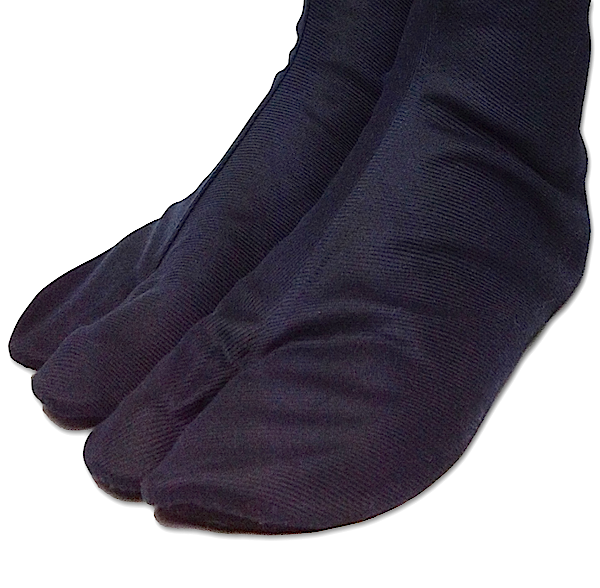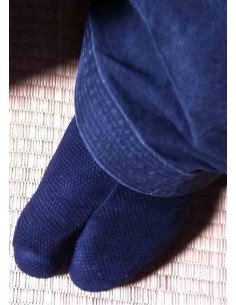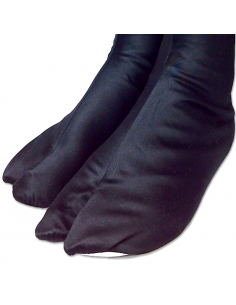- KyotoKimonoShop
- Tabi
- 0 likes
- 5352 views
- 0 comments
Japanese Tabi:
Everything About Japanese Tabi: A Comprehensive Exploration
 Introduction
Introduction
Step into the enchanting realm of Japanese culture as we embark on a journey to uncover the mystique surrounding Tabi socks. Derived from the Japanese term 足袋, meaning "foot pouch," Tabi socks are not merely a piece of footwear; they represent a profound connection to Japan's rich heritage.
In this exploration, we will delve into the origins and significance of Tabi socks, tracing their history back to the illustrious Heian period. Beyond being a practical garment, Tabi socks have played a pivotal role in religious practices, societal dynamics, and have left an indelible mark on the ever-evolving landscape of Japanese fashion.
Join us as we unravel the layers of symbolism, craftsmanship, and cultural impact woven into these distinctive split-toe socks. From their humble beginnings to their enduring presence in contemporary Japan, this journey promises insights into the essence of Tabi socks and their integral role in the tapestry of Japanese traditions.
History and Significance of Tabi
Let's delve into the river of time to grasp the captivating evolution of Tabi socks through the epochs at the heart of Japanese culture. We rewind to the roots of these unique garments, an adventure that begins during the prestigious Heian period.
Originally, Tabi served primarily religious functions, worn by monks to shield themselves from impurities when entering sacred temples. Their humble design in white cotton symbolized purity and signified respect for holy places.
With the rise of Japanese tradition and societal changes, the color and pattern palette of Tabi expanded, offering a variety of choices. These socks, initially reserved for sacred purposes, gradually transcended their religious role to become a distinctive element of Japanese fashion.
During the Meiji Period (1868-1912), Tabi evolved in sync with the changing needs of Japanese society. Trade with China allowed the importation of more cotton, expanding Tabi production. They ceased to be exclusively reserved for the social elite and became an indispensable accessory of the Japanese dress code.
The color of Tabi even began to play a crucial role, differentiating social classes. Colorful and printed socks were associated with musicians and artists, while black or navy was favored by travelers to conceal dirt marks.
In the Taisho period (1912-1945), brothers Tokujirō and Shōjirō Ishibashi introduced the Jika-tabi, an outdoor version of Tabi with a rubber sole, marking a new milestone in their evolution.
Thus, the evolution of Tabi socks reflects not only practical changes but also a cultural transformation, becoming a living testament to the richness and adaptability of Japanese fashion through the centuries..
Evolution of Tabi Over Time
1) Evolution of Tabi Over Time and Development of Manufacturing Techniques:
Tabi socks have undergone a remarkable evolution over the centuries, bearing witness not only to changes in fashion but also to advancements in manufacturing techniques. Originally, during the Heian period, Tabi were crafted from simple white cotton, primarily for religious purposes. However, as demand grew, and society evolved, new manufacturing techniques emerged.
The development of sewing techniques and the diversification of materials led to the creation of more durable and aesthetically varied Tabi. The introduction of the sewing machine during the Meiji era marked a significant turning point, accelerating production and paving the way for more intricate designs. Artisans began experimenting with embroidered patterns, colorful trims, and richer fabrics, giving rise to Tabi that transcended their initial function to become true works of art.
2) Expansion of the Color and Pattern Palette Over the Centuries:
The history of Tabi is also marked by a vibrant expansion of the color and pattern palette. Initially, the socks were of a clean simplicity, but over time, they evolved into an artistic canvas. During the Edo period, Tabi started featuring floral, geometric, and even animal motifs.
In the Meiji period, this trend intensified. Traditional Japanese patterns such as waves, cherry blossoms (sakura), and iconic animals found their place on Tabi. This expansion of pattern variety was made possible by improvements in printing and dyeing techniques. Tabi became a means of expressing creativity and artistic taste, surpassing their utilitarian function to become a style statement.
3) Social Classes and the Significance of Colors during the Meiji Period:
The Meiji period brought significant social changes, and Tabi were closely tied to these transformations. The colors of Tabi became a subtle yet powerful way to signify social status. Various shades were associated with different classes and professions.
Japanese musicians and artists adorned themselves with colorful and printed Tabi, symbolizing creativity and artistic expression. Samurai preferred gold or purple, reflecting nobility and bravery. White Tabi were reserved for Japanese events and ceremonies, emphasizing purity and tradition.
In contrast, black or navy Tabi were the choice of travelers, offering practicality by concealing dirt and travel traces. Thus, the colors of Tabi during the Meiji period were more than just a matter of fashion; they were a silent language, a means for society to communicate subtle information about the wearer.
Jika-tabi: A Crucial Innovation
1) Introduction of the Ishibashi Brothers and the Creation of Jika-tabi:
The history of Tabi socks takes a revolutionary turn with the introduction of Jika-tabi by the Ishibashi brothers during the Taisho period in 1922. Tokujirō and Shōjirō Ishibashi, inspired by the growing need for Tabi suitable for outdoor use, envisioned a shoe that would combine the functionality of Tabi with a durable rubber sole.
The term "Jika-tabi" itself reflects this innovation. "Jika" means "ground" in Japanese, emphasizing the intention to use these special Tabi directly on the ground, outside traditional houses. The Ishibashi brothers designed a sturdy rubber sole that provided superior grip, making Jika-tabi ideal for outdoor use, whether in fields, on construction sites, or in other demanding environments.
2) Impact on the Use of Tabi Outdoors and Daily Life:
The creation of Jika-tabi brought a significant transformation in how Tabi were used in daily life. Previously primarily reserved for indoor environments, Tabi suddenly found a place in outdoor and professional activities.
The rubber sole of Jika-tabi opened up new possibilities for workers and craftsmen. These shoes were now suitable for outdoor movement, providing additional protection against uneven ground and challenging weather conditions. Jika-tabi also won the hearts of farmers, fishermen, and construction workers, becoming a symbol of practicality and durability.
Beyond their practical utility, Jika-tabi also integrated into urban fashion. Young workers, attracted to their distinctive design, began adopting them in their daily lives, blending tradition and modernity.
Thus, the introduction of Jika-tabi marked a crucial step in the evolution of Tabi, expanding their application and placing them at the heart of Japanese daily life, where they continue to play an essential role to this day.
Why Wear Japanese Tabi Socks?
1) Comfort with Traditional Sandals and Adaptation to Modern Shoes:
Tabi socks have been specially designed to provide optimal comfort with traditional Japanese sandals such as geta or zori. Their unique design, with a separation for the big toe, allows for a perfect fit with the straps of these sandals, ensuring a comfortable experience during walking and movement.
Interestingly, although Tabi were initially designed for traditional footwear, they have also adapted to modern shoes. Modern shoe designs with a separation for the big toe, including some athletic shoes, also allow for comfortable wear with Tabi socks, showcasing their versatility in contemporary contexts.
2) Respect for Tradition during Special Events and Ceremonies:
Wearing Tabi socks during special events or ceremonies is more than just a choice of clothing. It is an act of respect for Japanese tradition. Tabi socks perfectly complement a kimono or yukata, adding an authentic touch to the outfit. It is a subtle way of showing attachment to Japanese culture and history.
Tabi socks are often chosen for significant occasions such as tea ceremonies, weddings, or other traditional rituals. Their presence at these events strengthens the connection between the past and the present, creating a rich and meaningful cultural continuity.
3) Practical and Aesthetic Functions of Tabi:
Beyond their traditional role, Tabi socks offer practical and aesthetic functions. Their separation of the big toe can help maintain a comfortable grip with sandals, preventing slipping. Aesthetically, Tabi socks are available in a variety of patterns, colors, and designs, transforming them into true fashion accessories.
Some even believe that the separation of the big toe can have benefits for foot health, improving circulation and reducing tension. Thus, Tabi socks become not only a clothing choice but also a way to care for foot well-being.
In conclusion, wearing Tabi socks goes beyond simple utility. It is a choice rooted in tradition, offering comfort, aesthetics, and cultural respect, making Tabi an essential element of the Japanese wardrobe.
Frequently Asked Questions about Tabi Socks
- 1) How to choose the size of Tabi?: Choosing the right size for Tabi is crucial to ensure a comfortable fit. It is recommended to refer to the brand-specific size guide. Generally, Tabi comes in standard sizes, but it's always best to measure the foot's length precisely and consult the brand's recommendations to ensure an optimal fit.
- 2) Can Tabi be worn with modern shoes?: Yes, Tabi is not limited to traditional sandals. They can also be worn with modern shoes, especially those with a separation for the big toe, like some athletic shoes. This broadens style options, allowing fashion enthusiasts to blend tradition and modernity.
- 3) What is the meaning of Tabi colors?: The meaning of Tabi colors dates back to the Meiji period. During this time, the colors of socks were often associated with different social classes. For example, vibrant and printed colors were reserved for musicians and artists, while colors like gold or purple were worn by samurais. Thus, the color of Tabi could indicate social status or a special occasion.
- 4) How to maintain Tabi to ensure their longevity?: Maintaining Tabi is essential to ensure their longevity. It is recommended to gently hand wash them with a mild soap. Avoid high temperatures and machine drying as it could damage the fabric. Air dry them and avoid direct sunlight exposure to preserve their colors.
- 5) Are Tabi suitable for all seasons?: Tabi is suitable for different seasons due to their versatile design. Lightweight cotton models are perfect for summer, offering optimal breathability. For winter, Tabi made from insulating materials can provide additional protection against the cold. Thus, regardless of the weather, there are Tabi options suitable for every season.
Cultural and Societal Impact
1) Maintenance of Cultural Relevance Despite Japan's Modernization:
Japanese Tabi socks have managed to maintain their cultural relevance even through periods of Japan's modernization. Despite rapid changes in Japanese society, Tabi socks continue to symbolize a connection to ancient traditions. Their distinct design, inherited from the past, provides cultural continuity, serving as a bridge between Japan's rich history and its modern future.
The persistent use of Tabi in various contexts, from traditional ceremonies to contemporary events, attests to their enduring cultural value. This underscores how the Japanese place importance on preserving their cultural heritage, even in a constantly evolving world.
2) Testimonials of Continued Importance of Tabi in Daily Life:
Tabi socks continue to have a significant impact on the daily lives of the Japanese. Testimonials highlight their versatility as these socks are worn in various settings, whether at work, at home, or during leisure activities. Contemporary testimonials shed light on how Tabi socks offer exceptional comfort, reinforcing their relevance in the modern world.
Professionals, martial arts enthusiasts, artists, and even those seeking a touch of tradition in their daily lives adopt Tabi socks as a practical and cultural choice. These testimonials illustrate how these socks continue to enrich the daily lives of individuals across generations.
3) Exploration of Tabi's Influence in Contemporary Art and Fashion:
The influence of Tabi socks extends beyond daily life to contemporary art and fashion. Renowned fashion designers incorporate Tabi socks into their collections, giving rise to unique creations that blend tradition and modernity. These socks have become a source of inspiration for designers, reaffirming their place as iconic elements of Japanese culture.
Contemporary art explores Tabi socks as a subject, highlighting their cultural significance through visual works, performances, and other artistic expressions. This artistic exploration contributes to maintaining interest in Tabi socks within contemporary society.
In conclusion, the cultural and societal impact of Japanese Tabi socks transcends the realm of clothing to become a source of inspiration and connection to Japan's cultural roots, attesting to their prominent place in modern society.
Conclusion:The Inexhaustible Richness of Japanese Tabi Socks
Through the twists of time, Japanese Tabi socks stand as more than a mere pair of socks. They are the silent witnesses of a rich and intricate history, a bridge between the past and the present, an icon of Japanese culture. The persistence of their distinct form, the separation of the big toe, and their unique style is a tribute to tradition that bravely withstands the onslaught of modernity.
The history of Tabi dates back to times when spirituality and functionality intertwined in the daily lives of the Japanese. From sacred temples to traditional homes, from battlefields to bustling streets, Tabi socks have left their mark in every corner of the Japanese landscape.
Over the centuries, Tabi socks have evolved from simple white socks symbolizing purity to complex fashion statements, combining color and pattern. Their social significance during the Meiji period has left an indelible mark, dividing society through nuanced shades.
The introduction of Jika-tabi by the Ishibashi brothers was a revolution, transforming these socks into sturdy and functional outdoor shoes. This marked a crucial turning point in the everyday use of Tabi and expanded their scope beyond traditional contexts.
Wearing Tabi is not just a matter of comfort or style; it is an act of respect for a deeply rooted culture. These unique socks have adapted to the changes in Japanese society while retaining their timeless essence.
In a constantly changing world, Tabi persist as a living heritage, reminding current generations of Japan's cultural richness. Whether worn during traditional ceremonies, contemporary events, or simply in daily life, Tabi continue to weave connections between the Japanese and their history.
In conclusion, behind each pair of Tabi lies a captivating story, a breathing culture, and a tradition that refuses to fade. Japanese Tabi socks are not just socks; they are guardians of the Japanese soul, reminding everyone that true beauty lies in preserving one's cultural identity—one pair of socks at a time.







Comments (0)